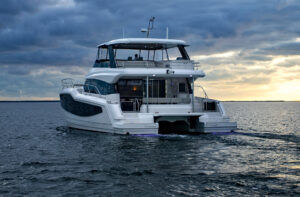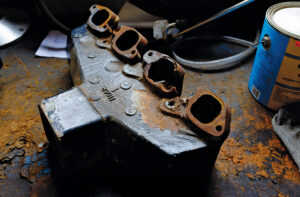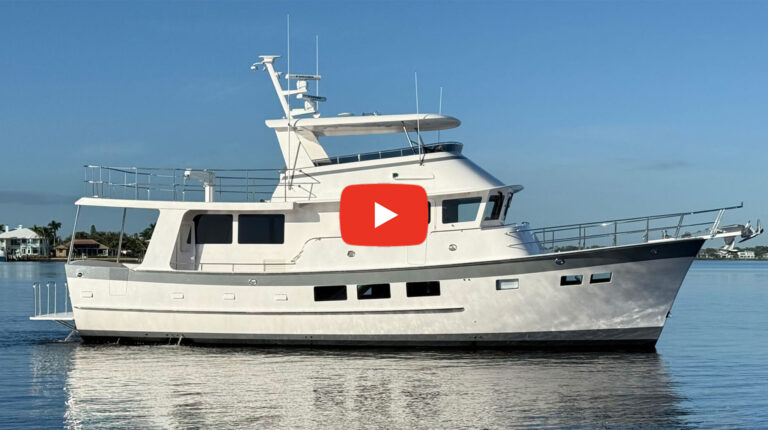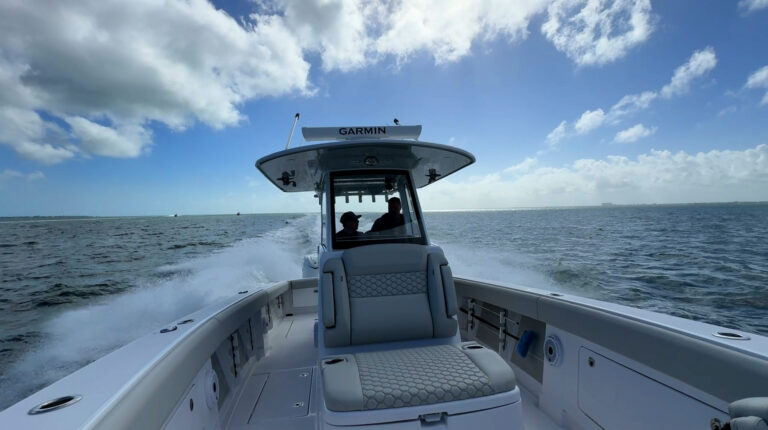Photography by Edwina Stevenson
The Heart of the Matter
With hundreds of inspections under his belt, Capt. Richard Thiel explains what engine room essentials you need to look for.
I have a friend who has owned 15 boats, including his latest, a 62-foot custom sportfish, and he loves to tell anyone who will listen that he always adheres to one rule when shopping for a boat (which he is doing now). “I always start in the engine room. The engine room is where the guts of a boat are exposed so you can tell just how serious a builder is about engineering and quality.”

I should add that my friend’s wife does not share his philosophy; she always begins her examination in the galley. And you may also demur from his strategy, but even if you do you can’t take issue with the importance of a thorough examination of the engine room as an important step in the process of shopping for a boat, be it new or used. You may be thinking that, not being mechanically inclined, you have no idea what to look for down there and besides, you’re never going to venture into the bowels of your boat anyway. But I can give you three reasons why you need to judiciously evaluate the engine room of every boat you seriously consider purchasing.
For one thing, many a boater thinks he or she will never enter an engine room only to be confronted by a mechanical problem that demands immediate action. At such a time, when your anxiety level is high and your rationality is low, a well-designed mechanical space that has everything accessible, logically arranged, and properly labeled can help you find and fix the problem, or at the very least identify it.
For another, even if you don’t go into your engine room and instead rely on your mechanic to do everything—a risky strategy—a proper engine room can make his life a lot easier. And why should you care about that? Because mechanics charge by the hour, the less time it takes for him to navigate your engine room the less he’s going to charge you. Further, as a former mechanic, I can tell you that it is much more pleasant to work in a well-designed engine room than the opposite, and when someone’s working environment is more pleasant, he or she almost always does a better job.

Before I address the third reason and talk about what constitutes a good engine room on a boat, let’s discuss what is probably a major concern of yours at this point: Can the average mechanical layman really recognize a good engine room? Don’t you need to have at least some expertise?
Fortunately you do not need to be a mechanic, or even mechanically inclined, to tell a good mechanical layout from a bad one. Much of the evaluation process involves simple common sense and the application of the same logic you employ when looking at the rest of the boat. Don’t be intimidated. Trust your intuition and first impressions. But also spend some time getting a feel for the space, and when you do, here are a few things to look for:
ACCESS
How easy is it to get into the engine room? Imagine the boat is pitching in a seaway and you’re trying to navigate a ladder or stairs to get to the engines or genset. Is the ER entrance protected or do you have to walk out into a potentially dangerous area like a swim platform to enter it? Are there handholds and nonskid steps to make the trip safer? If there’s a ladder, will you need to remove it to access key components—as is the case on some midcabin cruisers? Is there a secondary access in case using the first one isn’t practical? Can you turn on the ER lights before you enter? Is there a window so that you can clearly see what’s going on inside before you crack the door or hatch? This can be particularly important in the event of fire or flooding.

LIGHT
Turn on the ER lights. Is the space bright? Are the corners of the space, top and bottom, illuminated well enough so you could spot a leak or an errant part? Is there emergency lighting; that is, a secondary system that will function if the main electrical system goes down? Is there an auxiliary light that you can carry to a specific location?
WORKING ROOM
Adequate space to move around is important, and that includes headroom. Obviously the amount of it is a function of the size of the boat; on smaller vessels you probably can’t avoid stooping or even crawling on your hands and knees to reach the forward bulkhead, but if that’s the case, key components like fuel-water separators and fuel valves should be as close to the entrance as possible.

The walkway between the engines should be clear. Do components like separators and oil-change system controls intrude? Protrusions in the overhead can also make moving forward difficult if not downright hazardous. I was recently on a boat in which the outlet for the fire-suppression system was directly over the center walkway. Yes, it was painted red and yes it was covered by a protective cage, but that didn’t stop me from banging my head into it.
Again, imagine you’re down here in a seaway. Are there rails or handholds to keep you from being thrown against a hot engine or moving parts like a propsaft? How much clearance is there between the engines and the overhead? Can you walk between the engines and the forward bulkhead or the hull sides without touching a moving or hot part? Is the marine gear output flange and propshaft shaft shielded so that you can’t inadvertently contact it? Are there handholds with which you could steady yourself in a seaway? On a pitching boat you’re liable to grab onto the nearest thing to steady yourself, even if it’s hot, sharp, or spinning.


COMPONENT ACCESS
Boat designers employ some basic design elements to make life easier for those of us who do our own maintenance. Placing filters and dipsticks inboard has thankfully become a nearly universal practice. On the other hand, fuel-water separators—especially those for gensets—can be stuck almost anywhere. Separators usually have clear settling bowls that trap water and particulates, but if you can’t get close enough to look into them and see water, they’re basically worthless. Mounting separators aft, so you don’t have to walk all the way forward, increases the odds that you will regularly check them.
Bilge pumps, float switches, raw-water strainers, and seacocks are all components that you may need to access in a hurry. Mounting them in nether regions or concealing them beneath floor panels creates a more attractive, uncluttered engine room but can also make reaching them—whether for routine maintenance or in an emergency—more difficult. An emergency engine-driven bilge pump can be a lifesaver but also can be a bear to get to in a flooded ER if the lever for it is mounted all the way forward and at or below floor level. The same is true for batteries. Proper procedure dictates that they be located in dedicated and properly vented containers, but even gel cells and AGMs should be occasionally checked for corrosion and loose connections. That’s difficult to do if you can’t get the lid off the battery container because other components are blocking access.
The ideal fuel-tank design is a single tank with no manifolds to fiddle with. But to get maximum fuel capacity, builders must often resort to multiple tanks. There’s nothing wrong with that as long as the manifold controls are logically arranged, clearly labeled, and easily accessible. If a fuel-transfer pump is necessary to move fuel around the various tanks there should also be either a manual or electric backup. Tank manholes that allow the cleaning of interiors and sight gauges are two valuable features.
SAFETY
Because an engine-room fire is a major concern on any vessel there are plenty of regulations that ensure builders design their engine rooms with fire safety as a paramount consideration. Just about any vessel built in the last two decades will have a fire-suppression system, but not all have been installed correctly. For maximum effectiveness, the discharge outlet(s) should be mounted as close to the overhead as possible, which will ensure maximum agent dispersion. When a fire-suppression system is triggered, it should automatically shut down any ventilation fans and preferably close all ER vents. Otherwise the agent will simply escape into the atmosphere. And make sure there is a manual control so you can trigger the system without entering the ER.
Most onboard fires start in the mechanical spaces, and many of those start small and could be extinguished before they become conflagrations. The presence of a large portable fire extinguisher rated B (for use on liquid fires) and mounted in a designated and easy-to-reach location like a lazarette indicates a builder who’s carefully thinking about fire prevention and suppression.
VENTILATION

Engines, be they gasoline or diesel, are essentially air pumps, and so they demand a proper supply of clean, cool air for optimum performance. Automatic intake and exhaust fans not only ensure the engines get all the air they need but that the engine room stays comparatively cool, making it an easier place to work in. Some ventilators are thermostatically controlled so that even when the engines stop running they are still reducing the temperature of the ER. Comfort is not the only concern here; heat from an engine room can migrate to occupied areas of the boat creating an additional burden for the vessel’s air-conditioning system.
Today, most engines come standard with combination air-intake filter/silencers, but these don’t effectively deal with damp air that is laden with salt. Demisters remove most of this contaminant before it reaches the engines and in the process extend their life.
LABELS

Sitting in the comfort of your saloon, you may know where all the various fuel, electrical, and mechanical controls are in your engine room. But in an emergency clear thinking may often elude you. That’s why labeling is so important. Most builders do a good job of identifying electrical components but are often not so scrupulous at labeling engine room valves. When it comes to labels, the rule is simply the more the better.
CLEANLINESS
A new boat’s ER will undoubtedly be spotlessly clean, but the same should be true of a used boat. Oil and fuel leaks are not the norm; they are signs of poor maintenance and portend trouble. If an engine room is not sparkling clean, it means the previous owner did not take care of the boat and the next one won’t be able to spot leaks and other signs of trouble quickly when they do occur.
All this may seem like an imposing list but there’s a simple, common thread running through it: Each feature works to create an engine room that, as much as possible, not only eliminates stress and confusion in an emergency, but also helps you stop and think. In an emergency, intuition translates into immediate action that can spell the difference between inconvenience and calamity. A good engine room makes your life afloat easier.
So what about that third reason why you should judiciously evaluate the engine room? It’s pride. My same pal who always goes to the ER first when evaluating a possible purchase also goes to it first when he’s showing someone his own boat. Just as a proper ER shows you that a builder was serious about engineering and quality, it also tells you an owner knows how to recognize a good boat and take care if it.
Want to learn even more? The diesel engine is the beating heart of your boat. Arguably, a good running engine is your most important single piece of safety gear. Diesel engines are economical, long-lived and reliable, yet there are a number of ways in which they can fail. This seeming contradiction brings us to the distinction that has shaped the Online Marine Diesel Maintenance & Troubleshooting course.Sign up today and use the coupon code: POWERMOTOR for 15% off.










